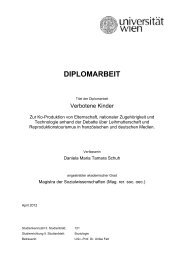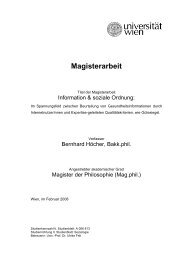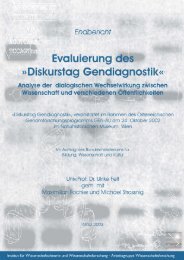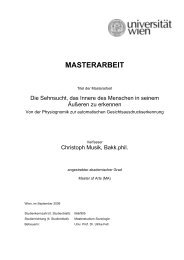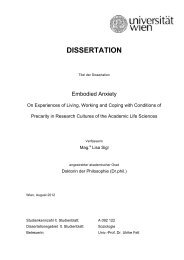MASTERARBEIT - Institut für Wissenschaftsforschung - Universität ...
MASTERARBEIT - Institut für Wissenschaftsforschung - Universität ...
MASTERARBEIT - Institut für Wissenschaftsforschung - Universität ...
Create successful ePaper yourself
Turn your PDF publications into a flip-book with our unique Google optimized e-Paper software.
4.3 tying together sociotechnical imaginaries and scot 37<br />
we choose to live in it. Knowledge and its material embodiment<br />
are at once products of social work and constitutive<br />
of forms of social life.“ (Jasanoff, 2004, p. 2) The<br />
idea is to explain the developments of society and technology<br />
as two sides of the same coin. This borders on thick<br />
description and answering ‘how’ questions, rather than<br />
answering ‘why’ questions with clearly explicated causal<br />
chains.« [3, 69]<br />
Yet while these concessions open SCOT in terms of conceptually integrating<br />
technology’s influence in society, the temporal dimensions remain<br />
very implicit. Hence Jasanoff’s concept of imaginaries remains<br />
very relevant to my work in order to integrate the anticipatory aspects<br />
imaginaries raise and their consequences as well as power. Ulrike<br />
Felt adds to the explication of an aspect of sociotechnical imaginaries<br />
that is very crucial and was not mentioned by Jasanoff before. In<br />
her recent contribution »Keeping Technologies Out: Absent presences and<br />
the formation of national technopolitical identity« [14], she is particularly<br />
concerned with the question how sociotechnical imaginaries build up<br />
over time. This aspect is very helpful answering the ’how’-question<br />
just referred to by Bijker. It enables us to see and take notice of<br />
changes imaginaries undergo over time. In her conceptualization of<br />
how discourses about sociotechnical imaginaries stabilize, Felt speaks<br />
of »memory practices« [14, 11]. She describes the discourse as a series<br />
of rehearsals in which different perceptions of a technology are ’tried<br />
out’. Each ’performance’ is then evaluated and remembered during<br />
following discourse rehearsals. This way, the rehearsals lead up to a<br />
finished play, a studied performance that has proven reliable and can<br />
be stuck to over time. Those construction processes are called assemblages<br />
in her approach: Out of several interpretations and pieces of<br />
imaginaries, a stabilized ’assemblage’ is formed. Also, the experience<br />
from a discourse emerging in a specific socio-technical setting can easily,<br />
as is demonstrateD, influence and/or support another. This way,<br />
technological cultures can form over time and evolve through the experiences<br />
they make during this process. This piece is particularly<br />
important as we will see that the imaginaries carrying the Zeppelin<br />
phenomenon were themselves „standing on the shoulders of giants“<br />
if one wants to alienate the expression; important discourses prior<br />
and parallel to the development of Zeppelin’s airship played a big<br />
role. Proceeding with the efforts of relating sociotechnical imaginaries<br />
to SCOT, assemblages might be presentable as an alternative notion<br />
for the actual process of stabilization and thus in its details provide a<br />
further level of analysis SCOT does not dive in too deeply.



